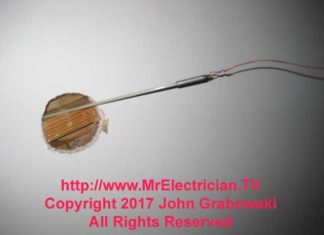Tag: Fish Wires With Coat Hanger
Wire Pulling In Walls Ceilings
Dear Mr. Electrician: How do I pull wires in walls and ceilings? Can I use a metal coat hanger for wire pulling?
Answer: Several methods and tools are available for wire pulling in walls and ceilings. How to pull wire depends on the wall or ceiling construction and the tools that are available at the moment.
Table of Contents:
Wire Pulling Through Walls and Ceilings
Using Fish Rods
How to Use Wire Coat Hangers
NOTE: Some text links below go to applicable products on Amazon. As an Amazon Associate, I earn from qualifying purchases. Using my links helps to keep this website FREE.
WIRE PULLING THROUGH WALLS AND CEILINGS
My experiences using metal wire coat hangers to fish wires through walls and ceilings have not been perfect. The steel wire used to manufacture coat hangers is a soft, mild metal that bends easily. When a coat hanger wire is pushed into a wall, it becomes distorted and is not very controllable as to direction.
However, I keep some metal wire hangers on my truck. I use them for hooking things and probing inside a wall or ceiling. More about coat hangers is down at the bottom of this post. A picture of my homemade tool from a coat hanger is below.
For working at home, where you probably will not install long electrical conduit runs, a twenty-five-foot fish tape would be adequate for your wire fishing jobs. I recommend at least a 1/8" x .060" size fish tape.
In my inventory of tools, I have several short pieces of fish tape of varying lengths from one foot to around eight feet. After getting bent or twisted incorrectly, they were all broken off of much longer fish tapes.
Top Of Page
A metal Fish Tape is made of hardened steel with some built-in flexibility. It is mainly rigid but can be bent slightly to get around obstacles. It is excellent for fishing wires in walls and pulling wires through conduits. If the hook breaks, you can heat the metal and bend a new one.
The sloped ceiling in the photo above made it easy for me to push my fish tape up into the attic. There was a space between the top plate of the wall and the ceiling joists big enough to put my hand through.
After I attached the Romex cable to the fish tape, I pulled it through a drilled hole in the top plate and fished it down the wall to a new switch box.
When I began working on electrical jobs in the early 1960s, the metal fish tapes available were either loose or on a rigid metal reel. The loose fish tapes were usually coiled into a short, flexible metal conduit.
I would cringe whenever I had to rewind the fish tape onto one of those old metal reels. My hands would hurt from pulling it into the tight metal grooves. Eventually, an attachment winder was made to make the process easier. I was in wire-pulling heaven after my father bought a new plastic reel to wind the...
